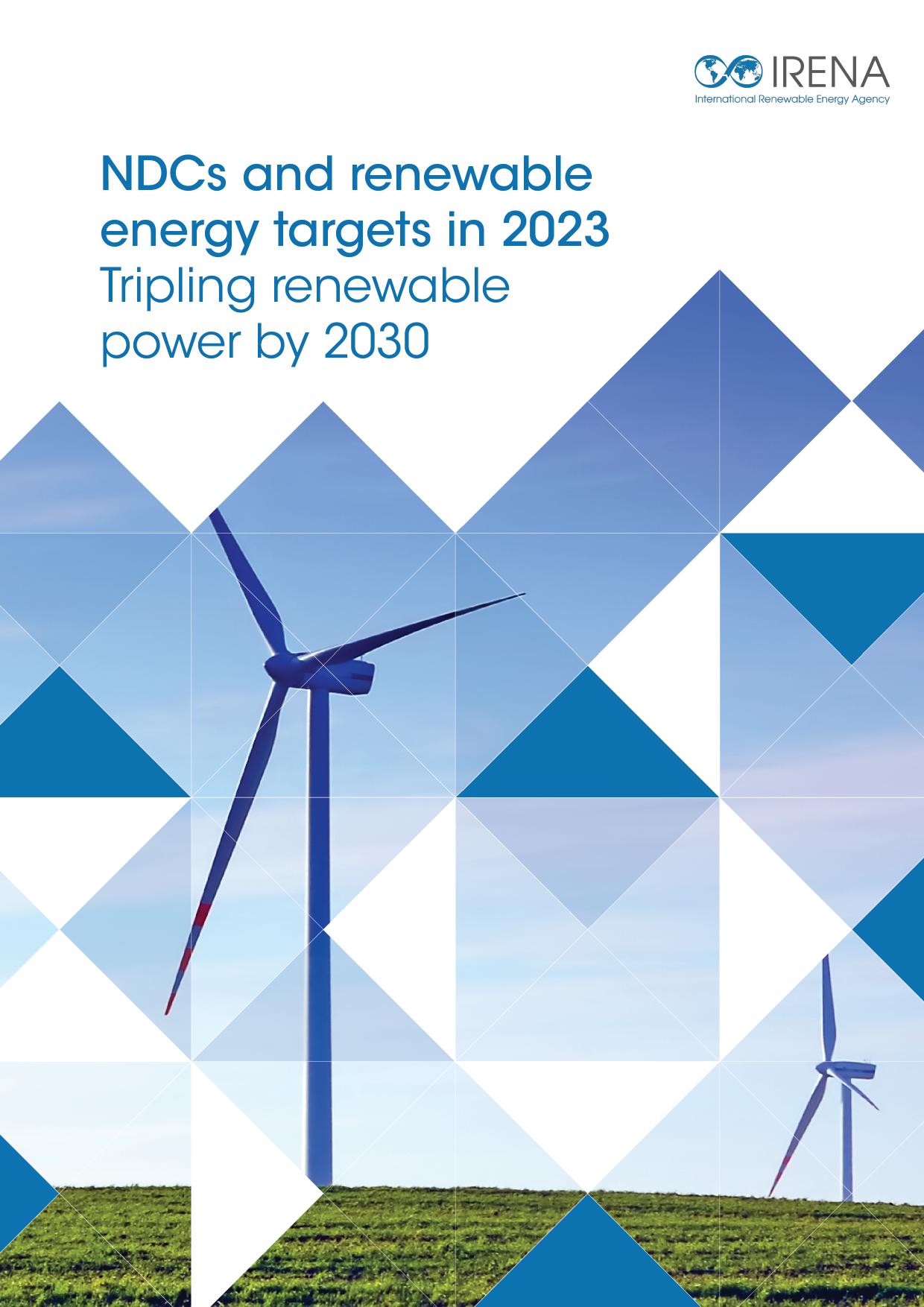©IRENA2023Unlessotherwisestated,materialinthispublicationmaybefreelyused,shared,copied,reproduced,printedand/orstored,providedthatappropriateacknowledgementisgivenofIRENAasthesourceandcopyrightholder.Materialinthispublicationthatisattributedtothirdpartiesmaybesubjecttoseparatetermsofuseandrestrictions,andappropriatepermissionsfromthesethirdpartiesmayneedtobesecuredbeforeanyuseofsuchmaterial.ISBN:978-92-9260-570-4Citation:IRENA(2023),NDCsandrenewableenergytargetsin2023:Triplingrenewablepowerby2030,InternationalRenewableEnergyAgency,AbuDhabi.ABOUTIRENATheInternationalRenewableEnergyAgency(IRENA)isanintergovernmentalorganisationthatsupportscountriesintheirtransitiontoasustainableenergyfutureandservesastheprincipalplatformforinternationalco-operation,acentreofexcellence,andarepositoryofpolicy,technology,resourceandfinancialknowledgeonrenewableenergy.IRENApromotesthewidespreadadoptionandsustainableuseofallformsofrenewableenergy,includingbioenergy,geothermal,hydropower,ocean,solarandwindenergy,inthepursuitofsustainabledevelopment,energyaccess,energysecurityandlow-carboneconomicgrowthandprosperity.www.irena.orgACKNOWLEDGEMENTSThisreportwasdevelopedundertheguidanceofUteCollier(ActingDirector,IRENAKnowledge,PolicyandFinanceCentre)andauthoredbyFaranRana,DialaHawila(IRENA)andAustinLee(IRENAConsultant)withvaluablecontributionsandfeedbackfromNaHeeLee,MirjamReiner,HannahGuinto,IrisvanderLugt,ToyoKawabata,MichaelTaylor,PaulKomor,VarvaraAleksićandInêsJacob(IRENA),MiquelMuñozCabré,CoraSalzano,MalvikaKaushik,andBrigitaTool(StockholmEnvironmentalInstitute),UniLee(EmberClimate)andKenichiKitamuraandRyoHamaguchi(UnitedNationsFrameworkConventiononClimateChange).ThereportwaseditedbyStefanieDurbin.IRENAisgratefulforthegeneroussupportforthisbriefprovidedbytheWalloongovernment.Forfurtherinformationortoprovidefeedback:publications@irena.org.Availablefordownload:www.irena.org/publications.DISCLAIMERThispublicationandthematerialhereinareprovided“asis”.AllreasonableprecautionshavebeentakenbyIRENAtoverifythereliabilityofthematerialinthispublication.However,neitherIRENAnoranyofitsofficials,agents,dataorotherthird-partycontentprovidersprovidesawarrantyofanykind,eitherexpressedorimplied,andtheyacceptnoresponsibilityorliabilityforanyconsequenceofuseofthepublicationormaterialherein.TheinformationcontainedhereindoesnotnecessarilyrepresenttheviewsofallMembersofIRENA.ThementionofspecificcompaniesorcertainprojectsorproductsdoesnotimplythattheyareendorsedorrecommendedbyIRENAinpreferencetoothersofasimilarnaturethatarenotmentioned.ThedesignationsemployedandthepresentationofmaterialhereindonotimplytheexpressionofanyopiniononthepartofIRENAconcerningthelegalstatusofanyregion,country,territory,cityorareaorofitsauthorities,orconcerningthedelimitationoffrontiersorboundaries.Covercredits:©Freepik.comCONTENTSFIGURES4TABLES4BOXES4ABBREVIATIONS5KEYMESSAGES6INTRODUCTION81�STATUSOFNDCSUBMISSIONSASOFEND-OCTOBER202392�STATUSOFRENEWABLEENERGYTARGETSINNDCsASOFOCTOBER2023133�ANALYSISOFRENEWABLEPOWERTARGETSINNDCsCONSIDERINGCALLSFORTHEPLEDGETOTRIPLECAPACITYBY2030163.1�G20Parties173.2LDCs243.3SIDS294�CONCLUSIONS31REFERENCES33APPENDIX36A1.�NoteontargetsinNDCsvs.policydocuments(laws,plans,roadmaps)36A2.Studydesign36A3.Quantificationmethodology373FIGURESFigure1NDCsbyambitionandshareofglobalemissions(asofendOctober2023)10Figure2�GlobalGHGemissionsprojectedunderNDCimplementation(forNDCssubmitteduptoSeptember2023)11Figure3�RenewableenergytargetsinNDCsglobally14Figure4�Globalpowersectortargetsfor2030toalignwiththe1.5°CScenario15Figure5G20renewableinstalledcapacity,historicaltrendsandfutureprojectionsbasedonNDCsvs.IRENA’s1.5°CScenario18Figure6�NDCtargetsinLDCsbyconditionalityandtheminimumleveloffinancingneeded24Figure7RenewableenergyinvestmentinLDCs,historicalinvestment(2013-2020)vs.futureinvestmentneeds(2023-2030)25Figure8RenewableenergytargetsintheNDCsofleastdevelopedcountries(LDCs),bytype27Figure9NDCtargetsinSIDSbyconditionalityandtheminimumleveloffinancingneeded29Figure10RenewableenergytargetsintheNDCsofSIDS,bytype30TABLESTable1JETPprogrammesbycountry,packagesize,donorsandtimeline20BOXESBox1IRENA’ssupportonNDCenhancementandimplementation12Box2�JustEnergyTransitionPartnerships20Box3�LegallybindingtargetsandaccountabilityintheUnitedKingdomandGermany22Box4�Long-termenergyscenarios(LTES)andlong-termlowGHGemissiondevelopmentstrategies(LT-LEDS)23Box5CommitmenttosupportrenewableenergydeploymentindevelopingcountriesintheUAE’sNDC26Box6�ImportanceofinternationalpartnershipsinfinancingrenewablesandachievingNDCtargets284ABBREVIATIONSCAGRcumulativeannualgrowthrateCO2carbondioxideCOP282023UnitedNationsClimateChangeConference°CdegreesCelsiusGtCO2eqgigatonneofcarbondioxideequivalentGWgigawattGWhgigawatthoursGFANZGlasgowFinancialAllianceforNetZeroGCFGreenClimateFundGHGgreenhousegasG20Groupof20IFIinternationalfinancialIPGInternationalPartnersGroupJET-IPJustEnergyTransitionInvestmentPlanJETPJustEnergyTransitionPartnershipLLDClandlockeddevelopingcountryLDCleastdevelopedcountryLTESlong-termenergyscenariosLT-LEDSlong-termlowGHGemissiondevelopmentstrategiesMasdarAbuDhabiFutureEnergyCompanyMtCO2eqmegatonnesofcarbondioxideequivalentMWmegawattMDBmultilateraldevelopmentbankNDCNationallyDeterminedContributionNCQGNewCollectiveQuantifiedGoalPACEPartnershipforAcceleratingCleanEnergyPVphotovoltaicSIDSsmallislanddevelopingStatesTWterawattUNCTADTheUnitedNationsConferenceonTradeandDevelopmentUNFCCCTheUnitedNationsFrameworkConventiononClimateChangeUAEUnitedArabEmiratesUKUnitedKingdomUSDUnitedStatesdollarsZARSouthAfricanrand5KEYMESSAGESCurrentcommitmentsonglobalactionagainstclimatechangeshowthatproposedmitigationmeasuresareprimarilyfocusedontheenergysector,whichmakesupmorethanthree-quartersofgreenhousegas(GHG)emissionsglobally.Transitioningtorenewableenergy–alongsideelectrificationandenergyefficiencymeasures,andphasingoutfossilfuels–isofparamountimportancetolimittemperatureriseto1.5degreesCelsius(°C).However,eightyearsaftertheParisAgreement,theambitionoutlinedinclimatecommitmentsfallsshortofdeliveringtheseclimategoals.Atotalof184partieshaveincludedrenewableenergycomponentsintheirNationallyDeterminedContributions(NDCs),butonly148ofthosehavequantifiedtargets.Ofthesetargets,113focusonpower.Decarbonisingpowerisbothcrucialandreadilyaccessible.AccordingtoIRENA’s1.5°CScenariooutlinedintheWorldenergytransitionsoutlook,morethanhalfoftheworld’senergyconsumptionshouldbemetwithpowerin2050.Meanwhile,powertechnologieslikesolarandwindhavereachedtechnologicalmaturityandcostcompetitivenessglobally.Nevertheless,moreconcretetargetsareneededforthedecarbonisationofend-usesectorsandapplications,mainlyheatandtransport,whichtogetheraccountformorethanthree-quartersofenergyconsumption.RenewableenergyambitionswithinNDCsarenotonlyinsufficient,theyalsofallshortofwhatcountrieshavecommittedtointheirdomesticpoliciesthatexistoutsidetheframeworkoftheParisAgreement(nationallaws,policies,roadmaps,plans,strategies).AsperIRENA’s1.5°Cpathway,andtheproposedCOP28pledgetotriplerenewablepowerglobally,theGroupof20(G20)alonewouldneedtogrowitsrenewablepowercapacityfromlessthan3terawatts(TW)in2022to9.4TWby2030,accountingfor80%oftheglobaltotal.ThecommitmentsmadeinNDCsarelessthanhalfofwhattheyneedtobetoalignwiththetriplingrenewablespledge,andthosemadeinnationalenergyplansandpoliciesfallshortby30%.ThisdiscrepancybetweenNDCsandnationalpoliciesandplanshighlightsacriticalissue:notallnational-levelrenewableenergycommitmentsarereflectedinglobalclimatepledges.Forexample,amongtheG20economiesthataccountforthebulkofglobalemissions,only13membershavesetrenewableenergytargetsintheirNDCs,althoughalmostallhavesetsuchtargetsdomestically.ThistranslatestoG20membersplanningtoinstall6.3TWby2030intheirnationalenergyplansandpolicies,comparedto4.6TWintheirNDCs.Acountry-levelcross-examinationofNDCsandnationalpoliciesshowsthatforthe95PartiesanalysedacrosstheG20,leastdevelopedcountries(LDCs)andsmallislanddevelopingStates(SIDS),onlyone-thirdofthePartieshavealignedtheirtargetswhiletherestremaincompletelymisalignedoronlypartiallyaligned.MisalignmentsbetweentargetssetinNDCsandnationalpoliciesunderscoretheneedforfurtherharmonisationbetweenclimatepledgestotheinternationalcommunity,andpolicyobjectivessetwithincountries’nationalcontexts.AligningrenewableenergytargetsinNDCsandnationalenergyplanswouldincreasetheeffectivenessandcredibilityofboth.Itwouldalsoreinforceclearsignalstoinvestors,developersandotherplayersacrossthesupplychain,thusenablingfurtherdevelopmentoftherenewableenergysector.Insomecases,thiswillinvolveestablishingorupdatingnationaltargets.Inothercases,itwillmeanincludingexistingnationaltargetsinthenextroundofNDCs.Attheotherendoftheemissionsspectrum,LDCsandSIDScontributelessthan5%ofglobalGHGemissions,yettheyaredisproportionatelyimpactedbyclimatechangeandremainparticularlyvulnerableduetotheireconomicstructures,limitedadaptivecapacityandgeographicallocations.Forbothgroupsofcountries,renewableenergyoffersopportunitiesforsocioeconomicdevelopment,increasedaccesstoreliableandaffordablecleanenergy,andenergysecurity.6KEYMESSAGESNDCsandrenewableenergytargetsin2023Tocapturetheseopportunities,LDCshavesettargetsintheirNDCsthatindicateanintentiontodoubletheircapacityasof2022–toreachtotalinstalledrenewablecapacityof105gigawatts(GW)by2030.Morethanhalfofthecapacitythatremainstobeadded–around30GW–isconditionaloninternationalsupportintheformoffinancing,technicalassistance,technologytransfer,capacitybuildingandotherformsofsupport.AmongtheSIDS,manycountrieshaveset100%renewablepowertargets(equivalenttoaround13GWtotalinstalledrenewablecapacityby2030)upfromlessthan6GWin2022,whichwouldhelpalleviatethefinancialdrainofimportingfossilfuels.SimilartoLDCs,almosthalfofthetargetedcapacityiscontingentonsupportfromtheinternationalcommunity.LDCsandSIDScontinuetolacktheresourcestoattractadequatelevelsoffinancing.Forinstance,during2013-2020,LDCsreceivedlessthanUSD(UnitedStatesdollars)30billioninrenewableenergyinvestments,equivalenttolessthan1%oftheglobaltotal,asharethathaslikelydroppedfurthersincethepandemic.ThisstandsinstarkcontrastwithamorethanUSD100billionofrenewableenergyinvestmentopportunityinLDCs,ascommunicatedthroughtheirNDCs.Mobilisingthisfinancing–ataffordableterms–bymeansofinternationalassistancerepresentsalitmustestagainstwhichhistorywilljudgetheeffortsoftheinternationalcommunitytoachieveajustandinclusiveenergytransitionforall.Suchsupportcanhelpfacilitatehigherenergyaccessrates,createsocio-economicbenefits,enhanceenergysecurityandbolsterresilienceagainstclimatechange.Butintheabsenceoflow-costfinancing,manyPartiesthathaveconditionalcommitmentsmayalternativelyopttolockthemselvesintofossilfuelinvestmentsthathavelowerupfrontcosts,precludingthemfromthebenefitsthatrenewablesoffer.Thiswouldnotonlydelaytheenergytransitionglobally,butitwouldalsoleavebehindthelowestincomecommunitiesandneglectagoldenopportunitytobridgesocio-economicgaps,aswellasachievethesustainabledevelopmentgoals.Theinternationalcommunitymuststepupandscaleupfinancingforajustandinclusiveenergytransition.PartofthisincludeshonouringtheUSD100billionperyearcommitmentofclimatefinancefromdevelopedtodevelopingcountries,whichhadnotbeenmetasof2021.PreliminaryfindingsfromtheOrganisationforEconomicCo-operationandDevelopmentsuggestthatthisgoalmayhavebeenmetforthefirsttimein2022,butthisissubjecttofurtherconfirmation.Inthegrandschemeofthings,thiscommitmentisrathersmall.Itisestimatedthatonaverage,aroundUSD9trillionclimatefinanceisneededgloballyuntil2030(upfromaroundUSD1.3trillioncommittedin2021-2022).The2023UnitedNationsClimateChangeConference(COP28)willsetthestageforacommitmenttoaNewCollectiveQuantifiedGoal(NCQG),withUSD100billionperyearasalowerlimit.Thismustbeaccompaniedbyabindingandrobustframeworkforactualdeliveryoffinancing.Inaddition,donorcountriesneedtointegratestrongerelementsofjusticeintheirsupport.Onewaytoachievethisisbyprovidingmoregrant-basedandconcessionalfinancing,whichalthoughintendedasacoreelementoftheJustEnergyTransitionPartnerships(JETPs),hassofarbeenmissingfromtheirfinancialstructures.Beyondinternationalcollaboration,progresstowardsmeetingrenewableenergytargetsinNDCsandenergyplansgloballyandachievingtheenergytransitionwillnecessitateovercomingdeeplyentrenchedbarriersstemmingfromthesystemsandstructurescreatedforthefossil-fuelera.Threepillarsformthefoundationsforawayforward:investingatscaleandbuildingthenecessaryinfrastructure,implementingthenecessarypolicyandregulatoryframework,andstrategicallyrealigninginstitutionalcapacitiestohelpensuretheskillsandcapabilitiesthatmatchtheenergysystemweaspiretocreate.Triplingrenewablepowerby20307INTRODUCTIONSincethehistoricsigningoftheParisClimateChangeAgreementin2015,nearlyallcountrieshavecommittedtoreducinggreenhousegas(GHG)emissionsthroughtheirNationallyDeterminedContributions(NDCs).Currentcommitmentsonglobalactionagainstclimatechangeshowthatproposedmitigationmeasuresareprimarilyfocusedontheenergysector(UNFCCC,2023),whichmakesupmorethanthree-quartersofGHGemissionsglobally(IEA,2023).Transitioningtorenewableenergy–alongsideelectrificationandenergyefficiencymeasures,andphasingoutfossilfuels–isofparamountimportancetolimittemperatureriseto1.5degreesCelsius(°C),accordingtoIRENA’sWorldenergytransitionsoutlook(IRENA,2023a).However,thecurrentambitionoutlinedinNDCsregardingrenewableenergydeploymentfallsshortofdeliveringtheseclimategoals.AccordingtotheUnitedNationsFrameworkConventiononClimateChange(UNFCCC),renewableenergy-basedmitigationmeasuresandtargetsarethemostfrequentlycitedcomponentsofcountries’climatecommitments(UNFCCC,2023).Ofthe196UNFCCCParties,184mentionedrenewableenergyintheirNDCsasakeymitigationstrategy.Ofthose,148Partieshavesetquantifiabletargetsforrenewableenergy,mainlyinthepowersector.Manyofthesetargetsremainconditionaloninternationalfinancialandtechnicalassistance.IRENAhasbeenanalysingNDCssince2019,focusingontheirrenewableenergycomponentsandhowtheycomparetowhatisneededtobeinlinewiththe1.5°Cgoal.ThisbrieffocusesonrenewableenergytargetsinNDCsasoftheendofOctober2023.Chapter1presentsthestatusofNDCsubmissionsintherun-uptothe2023UnitedNationsClimateChangeConference(COP28).Chapter2divesintothestatusofrenewableenergytargetsintheNDCs.Chapter3focusesonrenewablepowertargetsintheNDCs.ItanalysestheirlevelofambitionwithregardtoIRENA’s1.5°Cscenarioandthegoaloftriplingrenewablesinthepowersectorby2030andhighlightstheprogressmadewithrespecttothesetargets.Fordevelopingcountries,theanalysisidentifiestheportionoftargetsthatisconditionalonfinancialassistanceandtheminimumleveloffinancingneededtosupporttheachievementofthesetargets.Finally,thebriefexaminesthealignmentofrenewableenergytargetsinNDCswiththosesetinnationalplansandpolicies,includingwhetherthesearereflectedinlaws,policies,roadmapsandplans.1Whiletheanalysiscoversall195PartiestotheParisAgreement,2itzoomsinoncommitmentsmadebymemberswithinspecificgroups,suchastheGroupof20(G20),smallislanddevelopingStates(SIDS),andleastdevelopedcountries3(LDCs).G20membersaretheworld’slargestemitters,makingupmorethanthree-fourthsofGHGemissionsin2020(WorldBank,n.d.a).Theiractionstodaywillhavealargeimpactonmitigatingglobalemissionsgoingforward.Conversely,LDCsandSIDScollectivelyaccountforlessthan5%ofemissions(WorldBank,n.d.a)4butaredisproportionatelyaffectedbyandhighlyvulnerabletoclimatechange.AnanalysisoftheirtargetsinNDCsisimportant,asthesenotonlyreflectplanstoreduceGHGemissionsbutalsoshowtheopportunitiesforinternationalcollaborationthatexistthoughcommitmentsthatareconditionalonfinancialandtechnicalsupport.Capitalisingontheseopportunitiescanhelpcountriesincreaseenergysecurity,bolsterclimateresilienceandcapturearangeofsocio-economicbenefits.1Inthisbrief,renewabletargetsinNDCsaretreateddifferentlyfromtargetsinnationalpoliciesthatexistoutsidetheframeworkoftheParisAgreement.Formoredetails,refertotheAppendix(A1).2Upfrom194sinceIRENA’spreviousannualupdateinNovember2022.Eritreaisthelatestcountrytoratifytheagreement,on7February2023(UNFCCC,n.d.b).3LDCsaredefinedascountriesthathavelowlevelsofincomeandfaceseverestructuralimpedimentstosustainabledevelopment(UNDESA,n.d.).4SIDSmakeuplessthan1%oftheworld’sGHGemissions(WorldBank,n.d.a).8INTRODUCTIONNDCsandrenewableenergytargetsin20231Triplingrenewablepowerby203091SE�SNTUABDTM-UOISSCSOTIOOFNBNEDSRCA2S0O23FAsofendofOctober2023,atotalof108Partiesmakingup84%oftheworld’sGHGemissionshadupdatedandenhancedtheirNDCs.Still,thelevelofambitionofthecommitmentsmadetodateisnotsufficienttolimitglobaltemperatureriseto1.5°C.5BytheendofOctober2023intherun-uptoCOP28,almostallcountrieshadratifiedtheParisAgreementandsubmittedNDCs.Atotalof108Partiesmakingup84%ofworld’sGHGemissionshadupdatedtheirNDCsatleastoncesincetheirfirstsubmission,withclearenhancementsmadeinambitionintermsofemissionreductiontargets.ThelatestPartiestoenhanceambitionsinceCOP27inNovember2022includeAndorra,theBahamas,theEuropeanUnion,Mexico,Türkiye,Turkmenistan,theUnitedArabEmirates(UAE),UruguayandVietNam.Thereare70Partiesforwhichanenhancementofambitionisnotclearand17PartiesthatareyettosubmitanupdatedNDC.Collectively,thesePartiesrepresentaround16%ofglobalGHGemissions(Figure1).70Figure1�NDCsbyambitionandshareofglobalemissions(asofendOctober2023)NoindicationtosubmitEnhancedambition108Noclearindication7017195NDCssubmittedShareoftotalGHGemissions(2020)178Neworupdated84%10%6%NDCssubmitted108NDCsindicatingenhancedambitionNote:TheEuropeanUnionandits27MemberStatescommunicatedonejointNDCthat,forthisreport,hasbeencountedasoneNDCrepresenting28Parties.Sources:ClimateWatch(2023);WorldBank(n.d.b).5AsconfirmedbytheUNFCCCNDCsynthesisreport2023(UNFCCC,2023).101StatusofNDCsubmissionsasofend-October2023NDCsandrenewableenergytargetsin2023AlthougheffortstoenhanceNDCsarenotable,theUNFCCCNDCsynthesisreportshowsthatafullimplementationofactionsoutlinedinNDCssubmittedaheadofCOP28(uptoSeptember2023),includingallconditionalelements,wouldonlylimittemperatureincreaseto2.1-2.3°C.GlobalGHGemissionsin2030areestimatedtoremainconstantoratbestexperienceaslightreduction,rangingfrom48.3gigatonnesofcarbondioxideequivalent(GtCO2eq)to54.8GtCO2eqcomparedtotoday’slevelsof52.6GtCO2(UNFCCC,2023)(Figure2).AccordingtoIRENA’s1.5°CScenario,globalcarbondioxide(CO2)emissionsalonemustfallby30%ormorecomparedto2023levelstobelow25GtCO2by2030(IRENA,2023a).Thisconfirmsthattheoveralllevelofambitionfallsfarshortofsettingtheworldonaclimatesafepathway.Figure2�GlobalGHGemissionsprojectedunderNDCimplementation(forNDCssubmitteduptoSeptember2023)65GHGemissionsINDCsasat62.3(excludingLULUCF)(GtCO2eq/yearusingGWP-100fromtheAR6)4April2016605554.854.550NDCsasat48.34525September20234013530199520002005201020152020202520301990Note:INDC=intendednationallydeterminedcontribution,LULUCF=landuse,land-usechangeandforestry,GWP=globalwarmingpotentialandAR6=IPCC(2022).Source:UNFCCC(2023).IRENAhasengagedwithPartiestosupporttheirNDCimplementationandenhancementeffortsincollaborationwithdevelopmentagenciesandpartners.Thisengagementhasincluded26SIDS,22LDCsand21landlockeddevelopingcountries(LLDCs),contributingtocountries’climatepolicyandplanningprocesses(Box1).Triplingrenewablepowerby203011Box1.IRENA’ssupportonNDCenhancementandimplementationIRENAissupporting95PartiestotheParisAgreementandhasdelivered190activitiesrelatedtoNDCenhancementandimplementationthroughdirectcountryengagementincollaborationwithdevelopmentagenciesandpartners.IRENA’sclimateactionsupportactivitiescallontheagency’sexpertisetoincreaserenewableenergycapacityandimplementdifferentfacetsoftheenergytransition.IRENA’sworkpackagesinclude:•dataandstatistics•monitoring,reportingandverificationsystems•technologyandinfrastructuretechnicalanalysis•capacitybuildinginrenewableenergypolicyandfinance•resourceassessment•long-termenergyplanning•renewableenergypowersystemflexibility•renewablesreadinessassessments•renewableenergyroadmaps(REmap)•renewableenergyprojectfacilitationservices.Source:IRENA(2023b)121StatusofNDCsubmissionsasofend-October2023NDCsandrenewableenergytargetsin202322Triplingrenewablepowerby2030132�STATUSOFRENEWABLEENERGYTARGETSINNDCsASOFOCTOBER2023Ofthe148PartiesthathaveaquantifiablerenewableenergytargetintheirNDCs,113havepowertargetsandonly33havetargetsforendusessuchasheating,coolingandtransport,despitetheneedformoreambitious,concretetargetsforendusestoachieveclimategoals.RenewableenergyisakeycomponentoftheenergytransitionandthemostwidelyadoptedmitigationoptionforParties(UNFCCC,2023).Asofend-October2023,184PartieshadincludedrenewableenergycomponentsintheirNDCs,ofwhich148hadaquantifiabletarget.Only12Partieshadcommittedtoapercentageofrenewablesintheiroverallenergymixes.Ofthequantifiabletargets,113focusonthepowersectorandonly33coverotherendusessuchasheating,cooling,transportand/orcooking.Toachieveclimategoals,concreteandquantifiedrenewableenergytargetsforendusesbeyondpowerareneeded.Nevertheless,powersectortargetsarewelcomeandnecessary.InIRENA’s1.5°CScenario,by2050,halfofthetotalenergyconsumptioncomesfromelectricity(upfrom22%in2020),withover90%ofthatelectricitysourcedfromrenewables(comparedto28%in2020)(IRENA,2023a).Assuch,significantscalingupofrenewableenergydeploymentinthepowersector,togetherwiththeelectrificationofend-usesectorssuchasheatingandtransport,iscrucialtoachievingclimategoals.Ofthe113PartiesthathaddefinedtargetsforrenewablesinthepowersectorintheirNDCs,50presentedthemintheformofabsolutetargets,mostlyintheformofcapacity(megawatts,orMW)andafewintermsofoutput(megawatthours,orMWh).Ofthe63Partieswithtargetsdefinedasashareofthepowermix,13committoachievingarenewableenergysharelowerthan24%,24committoasharebetween25%and59%,14committosharesbetween60%and89%,and12committosharesbetween90%to100%,andmostoftheseareSIDS6(Figure3).Figure3�RenewableenergytargetsinNDCsgloballyTotalrenewablesmentions184Renewablestarget148EnergymixtargetsPowertarget113Non-power331250targetSharebased41CombinationCapacityandoutput-based220-24%25-59%60-89%90-100%13241412Note:RE=renewableenergy,MW=megawatts,MWh=megawatthours;numbersinFigure3correspondtothenumberofNDCsthatmentionaparticulartypeoftarget.6Barbados,CookIslands,Dominica,Fiji,Guyana,SaintKittsandNevis,Samoa,SolomonIslands,TuvaluandVanuatu.142StatusofrenewableenergytargetsinNDCsasofOctober2023NDCsandrenewableenergytargetsin2023Againstthisbackdrop,thePresidencyofCOP28,hostedintheUAE,hasbeencallingonpolicymakers,energyauthorities,industryandcivilsocietytoagreeonglobaltargetstotriplerenewablepowergenerationcapacitytomorethan11000gigawatts(GW)-or11terawatts(TW)-anddoubletheenergyefficiencyimprovementrateby2030(IRENA,2023c).Figure4showstheglobaltargetsrelatedtothepowersectoraccordingtoIRENA’s1.5°CScenariofor2030,alongwiththeprogressmadeinrecentyears.Therestofthisbrieffocusesonrenewableenergytargetsinthepowersector.Figure4Globalpowersectortargetsfor2030toalignwiththe1.5°CScenarioRECENTYEARS2030Totalinstalledcapacity(GW)20221446211174Totalinstalledrenewable8399capacity(GW)20223382Totalgeneration(TWh)2021401402283652021Renewableenergyshareingeneration(%)2021VREshareingeneration(%)2022Renewableenergyshareininstalledcapacity(%)Notes:GW=gigawatt;TWh=terawatt-hours;VRE=variablerenewableenergySource:(IRENA,2023c)basedon(IRENA,2023aand2023d).Triplingrenewablepowerby2030153162StatusofrenewableenergytargetsinNDCsasofOctober2023NDCsandrenewableenergytargetsin202333A�NALYSISOFRENEWABLEPOWERTARGETSINNDCsCONSIDERINGCALLSFORTHEPLEDGETOTRIPLECAPACITYBY2030ThissectionanalysesrenewablepowertargetsinNDCsasofOctober2023acrossfourdimensions.First,itquantifiesthemandanalysestheirlevelofambitionwithregardtoIRENA’s1.5°CScenarioandcallsfortriplingrenewablesgloballyby2030.Second,itlooksatprogressmadewithrespecttothesetargets,i.e.whatportionofthetargethasbeenachieved.Thethirddimensionisconditionality:fordevelopingcountries,theanalysisidentifiestheportionoftargetsthatareconditionalonfinancialassistanceandtheminimumleveloffinancingneededtosupporttheachievementofthesetargets.Thelastdimensionisalignmentwithnationalenergyplans,policiesandlaws,whichalsoindicateshowbindingthesetargetsare.ThisbuildsontherecommendationsfromIRENA’sreportRenewableenergytargetsin2022:Aguidetodesign,whichhighlightedthatforrenewableenergytargetsinNDCstobeimplemented,theyneedtobealignedwithrenewableenergytargetssetinnationalenergyplans,policiesandlaws(IRENA,2022a).ThisanalysisfocusesspecificallyonG20Parties,LDCsandSIDS.3.1�G20PARTIESClimatecommitmentsandrenewableenergytargetsofG20membersfalldrasticallyshortofthelevelsneededtolimitglobaltemperaturerisetobelow1.5°C.ThecommitmentsmadeintheirNDCsarelessthanhalfofwhattheyneedtobetoalignwiththeglobalgoaloftriplingrenewables,andtargetsinnationalenergyplansandpoliciesfallshortby30%.Thisnecessitatesanurgentandsignificantescalationofcommitments.Atthe18thG20SummitinSeptember2023,G20leadersdeclaredtheirintentto“pursueandencourageeffortstotriplerenewableenergycapacitygloballythroughexistingtargetsandpolicies,aswellasdemonstratesimilarambitionwithrespecttootherzeroandlow-emissiontechnologies,includingabatementandremovaltechnologies,inlinewithnationalcircumstancesby2030”(G20,2023).PerIRENA’s1.5°Cpathwayandthepledgetotriplerenewablepowerglobally,theG20alonewouldneedtogrowrenewableinstalledcapacityfromlessthan3TWin2022to9.4TWby2030,accountingfor80%oftheglobalshare.ThecommitmentsmadeinNDCsarelessthanhalfofwhattheyneedtobetoalignwiththetriplingrenewablespledge,andthosemadeinnationalenergyplansfallshortby30%.AsofOctober2023,13ofthe20membersoftheG20hadsetrenewableenergypowertargetsintheirNDCs.Aquantificationofthesetargetsfindsthatiftheywereallmetby2030,thiswouldresultinjust4.6TWofinstalledcapacityinG20economies(Figure5).However,lookingatthecommitmentsmadeinnationalpoliciesandplans(excludingannouncements),G20membersarealreadyplanningtoinstall6.3TW(Ember,2023).ThisshowsthatthecurrentambitionlaidoutinboththeNDCsandthenationalenergyplansofG20Partiesisinsufficient.Moreover,notallcommitmentsmadeatthenationallevelarereflectedinglobalclimatepledgesorNDCs.CurrentcommitmentsinNDCsandnationalplansarealsonotambitiouswhencomparedtorecentdeploymenttrends.G20Partieshavealreadymet64%ofthetargetedcapacityinNDCs,andhistoricaldatashowtheTriplingrenewablepowerby203017capacityaddedhasbeengrowingatacumulativeannualgrowthrate(CAGR)ofaround9.5%since2015.Ifthesamegrowthrateisretained,installedcapacitywouldreach6.1TWin2030.Thisisjustbelowthetotaltargetedcapacityinnationalpoliciesandplans.ThislackofambitioninbothNDCsandnationalpoliciesmayactuallyactasacaponrenewables,hinderingratherthanpromotingtheirdeployment.Figure5�G20renewableinstalledcapacity,historicaltrendsandfutureprojectionsbasedonNDCsvs.IRENA’s1.5oCScenario10TW9.4TW8TWIRENA1.5OC(G20)6TW4TW6.3TW2TWNationalpolicies6.1TWHistoricalCAGR2015-20224.6TWNDCs2.96TW(Current)0TW20122014201620182020202220242026202820302010MisalignmentsbetweentargetssetinNDCsandnationalpoliciesunderscoretheneedforfurtherharmonisationbetweenclimatepledgestotheinternationalcommunityandpolicyobjectivessetwithincountries’nationalcontexts.Amongthe13oftheG20PartiesthathaverenewablepowertargetsintheirNDCs,11arealignedwiththeirnationalpolicydocuments.7MexicoistheonlyG20Partywithapartiallyalignedtarget,8astheNDCcommunicatesatargetofapproximately40GWby2030,whereastheNationalElectricSystemDevelopmentProgram2023-2037(PRODESEN)targets52.2GWofinstalledcapacity(Ember,2023).WhileCanadahasanational-leveltargetinitspolicydocuments,itsNDCcommunicatesseveralpowertargetsatthestatelevel.Thealignmentcheckwasinconclusive,andtargetsdifferintermsoftheextenttowhichtheyarebinding.7OncearenewableenergytargetintheNDCisidentified(basedonthemethodologyintheAppendix),thetargetisconsideredalignedifitmatcheswiththeactivetarget(s)inthenationalpolicydocuments.Astargetsmaybeexpressedindifferentformats(e.g.capacity-basedvs.percentage-based),thealignmentisverifiedbyquantifyingthetargetsintermsofMW(seemethodologyintheAppendixformoredetails).Targetsareconsideredalignediftheyarewithin15%ofeachother.8AtargetisconsideredpartiallyalignedifboththeNDCandnationalpolicydocumentshavequantifiabletargetsbutthedifferenceexceedsthe15%differencecriteria–thismeansthatatleastpartoftheNDCtargetisreflectedinthenationalpolicies.183AnalysisofrenewablepowertargetsinNDCsNDCsandrenewableenergytargetsin20233Fortheremaining7PartiesthatdonothaveatargetintheirNDCsbuthaveoneintheirnationalenergyplans,thetargetsareconsideredmisaligned.9Whilesomeofthemisalignment,inthecaseofG20Parties,maybeduetonationalenergyplansbeingmoreuptodate,itmayalsoindicatethatrenewablesarebeingpursuedforobjectivesthatgobeyondclimate.Inanycase,commitmentstotheinternationalcommunityundertheParisAgreementneedtobemoreharmonisedwithtargetsinnationalenergyplans,andtheyneedtobemoreambitioustoachieveglobalclimategoals.DevelopingG20countriesarecallingforenhancedinternationalfinancialandtechnicalsupporttofulfiltheircommitmentsmadeintheNDCs.WhileJustEnergyTransitionPartnerships(JETPs)aregainingtractionasasupportmechanismtodeliverthesecommitments,considerableuncertaintyremainsregardingtheirsufficiency,fairnessandexecution.ConditionalityfeaturesinthecommitmentsofsomeG20countries.TheNDCsofIndia,IndonesiaandTürkiyesuggesttheneedforinternationalfinancialassistanceandtechnologytransfer.India’sNDCaimsat“50%cumulativeinstalledcapacityfromnon-fossilfuel-basedresourcesby2030,withthehelpoftransferoftechnologyandlow-costinternationalfinanceincludingfromGreenClimateFund(GCF)”(GovernmentofIndia,2022).Türkiye’sNDC(updatedin2023)includesan86GWrenewableenergytargetwhilespecifyingtheneedfor“significantinternationalfinancialsupportforitsclimate-friendlytechnicalassistanceandinvestmentprojects”(GovernmentofRepublicofTürkiye,2023).Indonesiahasincludedunconditionalrenewableenergytargets(aspartofitsCM1Scenario)butstatedthatfurthereffortswouldbepursuedshouldinternationalfinancialsupportbecomeavailable(CM2Scenario)(GovernmentofIndonesia,2022).Thisbringsunconditionalcommitmentstojust4.3TWofcumulativeinstalledcapacity(93%ofthe4.6TWcommittedinNDCs),while7%oftheoverallcapacitytargetedbyG20isconditionaloninternationalfinancialsupport.Fordevelopingcountries,mobilisingfinancingataffordabletermswillbekeytosupportingtheirenergytransitionsandpreventingthemfromlockingintounsustainablefossilfuelinvestments(IRENA,2023a;WorldBank,2023).Toaddressthis,theJETPshavebeendevelopedspecificallytoleverageconcessionalfinancingandtechnicalassistancefromdevelopedeconomies,toattractthenecessaryinvestmentfortransitioningcountriesfromfossilfuelstorenewables(Box2).9TargetsareconsideredmisalignedwhentheNDCdoesnothavearenewableenergytargetbutthereisanactivetargetinthenationalpolicydocuments(orviceversa).Triplingrenewablepowerby203019Box2.JustEnergyTransitionPartnershipsTheJETPsareinnovativefundingmodelsthatcansupportdevelopingcountriestoachievetheirenergytransitions.Underscoredbymulti-billion-dollarfinancialcommitments–fromtheInternationalPartnersGroup(IPG)10andotherpartners,suchastheGlasgowFinancialAllianceforNetZero(GFANZ)–theJETPsincludededicatedjusticecomponentstosupportthetransitionineconomicsectorsandcommunitiesadverselyaffectedbydecarbonisationefforts.Todate,fourJETPshavebeenagreed,asdescribedinTable1.Table1�JETPprogrammesbycountry,packagesize,donorsandtimelineBeneficiaryAmount(USD)DonorsTimelinecountrySouthAfrica8.5billionUnitedKingdom(lead),EuropeanUnion,2023-2027Indonesia20billion11France,Germany,UnitedStates.2023-20272023-2027Vietnam15.5billion12UnitedStates,Japan(leads),Canada,2023-2027Denmark,EuropeanUnion,France,Germany,Senegal2.7billionItaly,NorwayUnitedKingdom,andGFANZ.UnitedKingdom,EuropeanUnion(leads),CanadaDenmark,France,Germany,Italy,Japan,Norway,UnitedStates,andGFANZ.EuropeanUnion(lead),Canada,France,Germany,UnitedKingdom.Note:USD=UnitedStatesdollar.Sincethesepartnershipshavebeenestablished,somekeyissuesareevident.JETPsonlyrepresentasmallfractionoftherequiredinvestmentneededtomeettheNDCtargets.ThegovernmentofSouthAfricahasemphasisedthatthelowerendoftheNDCtarget–350-420megatonnesofcarbondioxideequivalent(MtCO2eq)by2030–isentirelyconditionalonavailablefinancing.TheJETPcommitmentstodate,however,onlyrepresentaround10%oftheinvestmentneededpertheJustEnergyTransitionInvestmentPlan(JET-IP),whichstandsatUSD80billion(equivalenttoZAR1.5trillion[SouthAfricanrand]).ThesamegoesforIndonesia.Thecountrycommitstoreducing1953MtCO2eqby2030,morethan80%ofwhichisconditionalonfinancialsupport.TheIndonesiangovernmentestimatesthatitwillneedatleastUSD96billionfornewrenewableenergygenerationandtransmissionanddistributionandanadditionalUSD150200billionannuallyfrom2021-2030forlow-carbonprogrammestomeetitsgoalofnetzerocarbonemissionsby2060orsooner(Reuters,2021a),makingtheinitialUSD20billioncommitmentfromtheJETPaminute,yetimportant,firststep.OthersourcesoffundingmustbetappedandmobilisedtoenablecountriestoachievetheirNDCtargets.10111210ComprisingCanada,Denmark,theEuropeanUnion,France,Germany,Italy,Japan,Norway,theUnitedKingdomandtheUnitedStates.11USD10billionofpublicsectorfinancefromIPGandUSD10billionfromprivatesectorfinancemobilisedbyGFFANZ.12USD7.75billionofpublicsectorfinancefromIPGandUSD7.75billionfromprivatesectorfinancemobilisedbyGFFANZ.203AnalysisofrenewablepowertargetsinNDCsNDCsandrenewableenergytargetsin20233Inaddition,theJETP’sfinancingcompositionsputintoquestionwhetherthesepartnershipsareindeedjust.Only4%ofSouthAfrica’sJETPisintheformofgrants,while81%arecomposedofloansandtherestareguarantees(ThePresidency-RepublicofSouthAfrica,n.d.).TheindicativemixforVietNam’sJETPfinancingpackageis1.3%ingrants(Chinh,2022),whiletherestisexpectedtoconsistofloans.ForIndonesia,onlyUSD292million(equivalentto2.5%ofpublicfundingcommittedbyIPGcountries)hasbeenearmarkedasgrants,whiletherestcomesintheformofloans,equityandguarantees(JETPIndonesia,2023).Furthermore,elementsfocusingonsocialjusticearequitesmallcomparedtoprojectsforlow-carbonandrenewableprojects.InSouthAfrica’sJET-IP,jobsandskillsdevelopmentaccountforonly0.17%ofthetotalamount(CenterforGlobalDevelopment,2023).Similarly,justtransitioncomponentsinIndonesia’sComprehensiveInvestmentandPolicyPlanareallocatedonlyUSD28.8millionor0.25%oftotalIPGfunding(excludingGFANZ).Athoroughassessmentofwhetherfinancingforsocialjusticecomponentsisadequateisneeded.Justicecannotbelargelycontingentonprivatefinancingandbankability(IRENAandCPI,2023).AhighershareofgrantsandconcessionalfinancingshouldbeacoreunderpinningoftheseJETPs.Thiscanhelplowertheoverallcostoffinancingandencouragesufficientcrowdinginoftheprivatesectortocoverthecapitalshortfall.MosttargetsinnationalpolicydocumentsthatalignwiththoseinNDCsarenotlegallybinding.ForG20membersthathavetargetsinNDCsthatarepartiallyorfullyalignedwiththosesetinnationalpolicydocuments,theirlevelofbindingnessvaries.OnlyfivePartieshavereflectedtheirNDCtargetsinanationallaw(orregionallaw,inthecaseoftheEuropeanUnion),whilesevenhaveonlyreflectedtheminplansandroadmaps.Intermsoftargetedcapacityby2030,about43%oftheadditional1672GWtobeinstalledbetween2023-2030pertheG20’sNDCcommitmentsislegallymandated(mainlyintheEuropeanUnionandIndonesia),and57%ispartofnon-bindingpolicydocumentssuchasplansandroadmaps.Makingrenewableenergytargetslegallybinding(includingothertargetsforthephaseoutoffossilfuels)canhelpprovidemoreclarityandcertaintytotheglobalcommunityofthecountries’renewableenergyambitions(JohnstonandvanderMarel,2016).Thisisimportantfortheinternationalcommunitytounderstandtherespectivecontributionofeachcountrytowardsmitigatingemissions,andtheglobalpledgetotriplerenewablesby2030.Itmayalsohaveaneffectdomestically,encouraginggovernmentstoallocatetherightlevelofresourcesandeffortstowardsenactingtheneededregulationsandincentives.Thiscaninturnprovideclearsignalsandincentivesforinvestorsandotherrelevantstakeholders,therebyfacilitatingthedevelopmentofrelevanttechnologiesandsupportingtheircommercialdeployment.Moreover,itallowsforgovernmentstobeheldaccountableandprovidefurthertransparencyregardingthemeasuresthatwillbeundertakentoachieveatarget–withtheUnitedKingdom(UK)beingacaseinpoint(Box3).Triplingrenewablepowerby203021Box3.LegallybindingtargetsandaccountabilityintheUnitedKingdomandGermanyIn2022,theUnitedKingdom’sHighCourtruledthecountry’snetzerostrategyunlawful,inbreachofthe2008ClimateChangeAct,whichlegallybindstheUKgovernmenttoreducingGHGemissionsbyatleast100%of1990levels(netzero)by2050(ClimateChangeCommittee,2023).Thecourtdeemedthenetzerostrategyinsufficientindeliveringtherequiredemissionreductionstomeetthe2050target,whilefailingtoprovidesufficientdetailsonhowthetargetcouldbemanagedundertheUnitedKingdom'slegallybindingcarbonbudgets.Withthisaccountabilitymechanisminplace,itbecamepossibletoassesswhethertheUnitedKingdom’spoliciesandplansalignwithcommitmentsmadetotheinternationalcommunityundertheParisAgreementframework.Thisdemonstrateshowestablishinglegallybindingtargetscanallowforgovernmentstobeheldaccountable,althoughwell-functioningandrobustlegalinstitutionsareprerequisitesforthisaccountabilitytobeachieved.Inresponsetothisruling,thegovernmentlaunchedapackageof44documents,includingaCarbonBudgetDeliveryPlaninMarch2023thatoutlinedhowthegovernmentintendstomeetitslegallybindingclimategoalsandtheemissionsimpactofgovernmentpoliciesoverthenext15years.However,thestatutoryadvisorybodyestablishedundertheClimateChangeAct,theClimateChangeCommittee,remainsconcernedaboutthelikelihoodofachievingtheUnitedKingdom’sfuturetargets.Accordingtothecommittee,recentpolicyannouncementswerenotaccompaniedbyestimatesoftheireffectonfutureemissions(ClimateChangeCommittee,2023).In2021,asimilarrulinginGermanyledtothegovernmentcommittingtoamoreambitioustargettobecomeGHGneutralby2045(comparedto2050earlier)afterthecountry’sconstitutionalcourtdeclaredtheclimateprotectionmeasuresinsufficient(Reuters,2021b).Source:CarbonBrief(2023).Tosupportenergysectorlong-termplanningandinformpolicymaking,manycountrieshavebeendevelopinglong-termenergyscenarios(LTES).WiththeadoptionoftheParisAgreementin2015,countrieswereencouragedtosubmitlong-termlowgreenhousegasemissiondevelopmentstrategies(LT-LEDS)totheUNFCCCtoinformlong-termclimatepolicy(Box4).223AnalysisofrenewablepowertargetsinNDCsNDCsandrenewableenergytargetsin20233Box4.Long-termenergyscenarios(LTES)andlong-termlowGHGemissiondevelopmentstrategies(LT-LEDS)AligningclimatecommitmentswithnationalenergystrategiesisakeyfocusnotonlyforNDCsbutalsoformorelong-termenergyandclimateplans.IRENA's(2023e)reportevaluatesthealignmentbetween24officialLong-TermEnergyScenario(LTES)documentsand36Long-TermLowGreenhouseGasEmissionDevelopmentStrategies(LT-LEDS)from45countries.Theassessmentaimstogaugealignmentatbothinstitutionalandtechnicallevels,identifyingareasforimprovement.ThefindingsindicatethatwhenLTESandLT-LEDSprocessesareharmonized,theresultingmitigationplansbecomemorerobust.Documentsstemmingfrommultipleorinterdisciplinaryministrieswithbothenergyandclimateintheirportfoliosofferscenariosthatencompassabroaderspectrumoftransitionalelements.Furthermore,theseprocessescanbuildoneachother;LTESprovide10-20%morequantitativeinsightsintoenergyproduction,transmission,distributionandstoragethanLT-LEDS,whileLT-LEDSofferaround10-15%morequantitativerepresentationofsocio-economicaspects.AsynergizedapproachtoLTESandLT-LEDSwouldcontributetoamorecomprehensivenationalstrategy.Thereportrecommendsbasingclimatechangemitigationstrategiesonscenarios,asthisfostersascientificallyrigorouscoordinationofplanningalignedwithresultantproposals.AsofOctober2022,36LT-LEDShaveincorporatedscenariosastheirprimarytooltodelineatealternativepathwaysandtargets,quantitativelyassessingtheshort-andmedium-termpoliciesrequiredtoachievelong-termobjectives.PreliminaryfindingsfromanupcomingIRENAstudyonLTESandLT-LEDSalignmentemphasisetheneedforalignmentbetweennationalenergyscenariosandinternationalclimatecommitments.Thereisagenerallackofquantifiabledata,especiallyonenergy-relatedindicators,inLT-LEDS,particularlythosethatarenotbasedonscenarios.Source:IRENA(2023e).Triplingrenewablepowerby2030233.2LDCsDespiteglobalcommitments,currentfinancialandtechnologicalsupportforLDCsremainsalarminglyinsufficient,necessitatingasignificantscale-upininternationalassistancetoachieveobjectivesthatinclude,butalsogobeyond,climate.LDCscontributetolessthan4%ofglobalGHGemissions(WorldBank,n.d.b)butareparticularlyvulnerabletoclimatechangeduetotheir“geographicallocation,economicstructures,labourmarketcompositionandlimitedadaptivecapacity”(UNDP,2022).AlmostallLDCshavesetambitioustargetsforrenewableenergydeployment,whichoffersanopportunityforsocioeconomicdevelopmentbasedonreliable,affordableandsustainableenergy.Atotalof46PartiestotheParisAgreementthatareclassifiedasLDCshavecommittedtoatotalof105GWofrenewableinstalledcapacityby2030intheirNDCs(atotalof47GWwasinstalledasof2022,outofwhichalmost90%ishydropower).About28GWremainstobeinstalledunconditionally–throughamixofdomesticandinternationalpublicandprivatefundingsources–andanadditional30GWisconditionalonsecuringadditionalinternationalfinancialsupport(Figure6).Theseconditionaltargetspredominantlyfocusonrelativelymoreemergingtechnologiessuchassolarphotovoltaic(PV)(49%),onshorewind(28%)andhydropower(20%).Incontrast,unconditionaltargets,whicharemorereliantondomesticpublicfunding,leanmoretowardshydropower(48%),followedbysolarPV(31%)andonshorewind(11%).Asunconditionaltargetsoftenrelyondomesticpublicsources,andhydropowerhastraditionallybeenfundedthroughpublicsources(oftendomestic),thisdifferenceintechnologicalbreakdownmakessense(IRENAandCPI,2023;Larosaetal.,2022).AminimumofUSD104billionisneededtoachieveLDC’sNDCtargetofinstallinganadditional58GWofcapacityby2030,outofwhichatleastUSD48billionmustbeprovidedthroughinternationalsources(conditional)(Figure6).Additionalsupportwillbeneededintheformoftechnicalassistance,capacitybuildingandtechnologytransfer.Figure6�NDCtargetsinLDCsbyconditionalityandtheminimumleveloffinancingneededOtherHydro-powerSolarWind120GW30GWUSD107billion100GW28%3%80GW60GW28GW49%USD5040GWbillion31%20%10%USD5748%11%billion47GW3%1%7%20GW0GW89%2030Unconditional2030ConditionalMinimuminvestment2022CapacityConditionalUnconditional243AnalysisofrenewablepowertargetsinNDCsNDCsandrenewableenergytargetsin20233RenewableenergyinvestmentsinLDCsmustmorethantripleintheperiod2023-2030comparedto2013-2020,duringwhichLDCsreceivedfewerthan1%ofglobalinvestments.Goingforward,theinternationalcommunitymustprovidelow-cost,affordablefinancingintheformofconcessionalloansandgrantstoenableLDCstopursuearenewable-poweredfutureandavoidlockingintounsustainablefossilfuelinfrastructure.ScalingupaffordablerenewableenergyfinancingtoLDCs,includingforoff-gridapplications,isofparamountimportancetoadvanceprogressonenergyaccessandachievebroadersocioeconomicdevelopmentgoals.Currently,481millionpeoplelackaccesstoelectricityinLDCs,andthisfigureisexpectedtogrowby2030(IEA,etal.,2023).IRENAandCPI’sGloballandscapeofrenewableenergyfinancereportshowsthatLDCshavereceivedlessthanUSD30billioninrenewableenergyinvestmentsbetween2013-2020,equivalenttolessthan1%oftheglobaltotal.Theirsharehaslikelydroppedfurthersincethepandemicasinvestmentsin2021-2022becamefurtherconcentratedinadvancedeconomiesincludingChina,EuropeandNorthAmerica(IRENAandCPI,2023).Theinternationalcommunitymuststepupitseffortstoaddressthisinequality.Developedcountrygovernmentsshouldworkwithdevelopmentpartners,particularlymultilateraldevelopmentbanks(MDBs),toexpandtheavailabilityofcapitalforpublicinvestmentsinrenewableenergyandtransformlendingtoLDCsbyprovidingmoregrantsandconcessionalfinancing(IRENAandCPI,2023;IEA,etal.,2023;DumaandCabré,2023)(seeBox6).ThereismorethanaUSD100billionrenewableenergyinvestmentopportunityinLDCs(Figure7)ascommunicatedthroughtheirNDCs.Failingtocapturethisopportunitycouldlockmanycountriesintofossilfuelinvestmentswithlowerupfrontcosts,andevenmore,itrepresentsakeytestfortheinternationalcommunitytocomethroughontheircommitmenttoleavingnoonebehind.Figure7�RenewableenergyinvestmentinLDCs,historicalinvestment(2013-2020)vs.futureinvestmentneeds(2023-2030)Renewableenergy50USDbillioninvestmentsinLDCsneedConditionaltomorethantriple57USDbillion29USDbillionUnconditionalCumulativeinvestmentsMinimuminvestmentsneeded(2013-2020)(2023-2030)Triplingrenewablepowerby203025Theinternationalcommunitymuststepupandscaleupfinancingforajustandinclusiveenergytransition,partofwhichalsoincludeshonouringtheUSD100billionperyearcommitmentofclimatefinancefromdevelopedtodevelopingcountries.Asof2021,thiscommitmenthadnotyetbeenmet,withclimatefinancingtotallinglessthanUSD90billionthatyear.Preliminaryfindingssuggestthatthisgoalmayhavebeenmetforthefirsttimein2022,butthisissubjecttoconfirmationatalaterstage(OECD,2023).Fromamacroperspective,thiscommitmentisrathersmall.Itisestimatedthatonaverage,aroundUSD9trillionclimatefinanceisneededgloballyuntil2030(upfromaroundUSD1.3trillioncommittedin2021-2022)(ClimatePolicyInitiative,2023).COP28couldsetthestageforacommitmenttoasignificantlyhigherNewCollectiveQuantifiedGoal(NCQG),withthepreviousunmettargetofUSD100billionperyearsetasalowerlimit(UNFCCC,n.d.a).However,moreeffortsareneededtoincreaseinternationalcollaboration,andthesecanbeincorporatedasakeypartofthecommitmentsbypartiestoachievingglobalclimategoals.ThisapproachisillustratedintheUAE’sNDC,whichhighlightsinvestmentsundertakenindevelopingcountries(Box5).Box5.CommitmenttosupportrenewableenergydeploymentindevelopingcountriesintheUAE’sNDCTheUnitedArabEmirates’s(UAE)NationallyDeterminedContribution(NDC)extendsitsclimate-relatedcommitmentsbeyonddomesticborders,byassistingdevelopingcountriesinmitigationandadaptationefforts.TheUAE’sNDChighlightsthatthecountryhassupportedrenewableenergyprojectsin70countries,includingin27islandnations,throughtheprovisionofmorethanUSD50billiondollarsincludingintheformofaidandconcessionalloans.Overthenextdecade,anadditionalUSD50billionisplannedwiththeintenttodeploy100GW.Theseprojectsareexpectedtomitigate86milliontonnesofCO2emissionsperyearby2030.Inaddition,theUAEisakeyfinancingpartnertotheEnergyTransitionAcceleratorFinancing(ETAF)Platform,providingmorethanUSD400millioninfunding.Finally,otherinternationalcollaborativeeffortssuchasthePartnershipforAcceleratingCleanEnergy(PACE)withtheUnitedStatesaimtomobiliseUSD100billiontodeploy100GWofcleanenergyintheUnitedStates,UnitedArabEmiratesandemergingeconomiesby2035.Source:UnitedArabEmiratesMinistryofClimateChange&Environment(2023).�©TippaPatshutterstock.com263AnalysisofrenewablepowertargetsinNDCsNDCsandrenewableenergytargetsin2023Moreover,LDCscanfurtherstrengthentheirNDCsbyaligningthemwithnationalplansandpolicies.LDCshavecommittedtoinstallingatotalof105GWofrenewableinstalledcapacityby2030pertheirNDCs,comparedto111GWinnationalplansandpolicies.Althoughthesefiguresareclose,acountry-by-countryanalysisshowsthatonly11havefullyalignedtheirrenewabletargetsinNDCswithtargetsintheirnationalplansandpolicies.Atotalof27PartieshadtargetsthatwerepartiallyalignedwhiletheremainingeightPartieshadtargetsthatwerecompletelymisaligned.Among38LDCsthathavefullorpartialalignment,onlyonetargetisreflectedinalaw,andanadditional16targetsaregovernedbypolicies.MostoftheParties’targetsremainpartoflessbindingroadmapsandplans(21)(Figure8),whichhintsatwhyasignificantportionofthetargetsareconditionalonfinancialassistance.Inotherwords,about23.5GWoftheadditionaltargetedcapacityby2030isgovernedbypolicies;24GWisgovernedbyplans,roadmapsandstrategies;andonly90MWisgovernedbyalaw,inthecaseofGambia.Figure8�RenewableenergytargetsintheNDCsofleastdevelopedcountries(LDCs),bytype1Laws163Policies21Roadmaps/plansCountriescanalsolinkNDCstoinvestmentpoliciesrelatedtoenergytransitionplans,therebyprovidinggreatercertaintyregardinginvestmentopportunitiesandpotentialprojectsavailableinthecountry.TheUnitedNationsConferenceonTradeandDevelopment(UNCTAD)hasanalysed147NDCssubmittedbydevelopingcountriesasofJuly2023,andfindsthatonly48provideinformationoninvestmentrequirementsand40discussprospectivesourcesofinvestment(Box6).Triplingrenewablepowerby203027Box6.ImportanceofinternationalpartnershipsinfinancingrenewablesandachievingNDCtargetsSignificantinvestmentisneededindevelopingeconomiestoachievetheenergytransitionandlimitglobalwarmingto1.5°C.WhilemanydevelopingnationshaveoutlinedgoalsfortheirenergytransitionsintheirNationallyDeterminedContributions(NDCs),onlyaroundathirdofthesecountries(48intotal)haveidentifiedinvestmentneeds.Evenfewercountries(40)haveproposedpotentialfinancingsourcesfortheirprojects,amongwhichthemostfrequentlycitedaremultilateraldevelopmentbanks(MDBs)andinternationalfinancialinstitutions(IFIs),inadditiontodomesticgovernmentfundingandprivateinvestmentfrominternationalsources.In2022,internationalprojectfinanceaccountedformorethanhalfofoverallprojectfinanceforrenewablesglobally.Thisshareishigherindevelopingcountries,exceeding75%inLDCs.ThishighlightstheimportanceofinternationalinvestmentinmeetingNDCtargets,particularlyfordevelopingeconomies.However,themajorityofthesenationsstillfacechallengesinattractingFDIoutsideoftheextractivesindustry.Tothispoint,31developingcountries,including11LDCs,havenotrecordedanyutility-scalerenewableenergyprojectsinvolvinginternationalinvestment.Moreover,otherareascrucialforthetransition,suchastheenablinginfrastructure(e.g.transmissionanddistribution),stillseemuchlowerinvolvementbyinternationalinvestors.Asrealandperceivedrisksremainhighinmanydevelopingcontexts,thistranslatestoahighcostofcapital–akeybarriertoattractinginvestments.Manydevelopingcountries,includingLDCs,resorttotaxincentivesastheydon’trequireimmediatespendingoflimitedpublicfunds.Buttheforgonegovernmentrevenuecanbecostlyinthelong-run.Moreover,theymaynotdirectlyaddressthekeychallengesfacebyinvestorsandkeepoverallcostsofcapitalhigh.Bringingininternationalinvestorscanhelplowerthecostofcapital.Forexample,bringingininternationalinvestorslowersthespreadondebtfinance(thedifferencebetweentheinterestratechargedonaloanandabenchmarkinterestratesuchastherisk-freeratefromagovernmenttreasurybondforinstance)by8%;addinginMDBslowersitby10%.Acombinationofinternational,MDBandgovernmentinvestmentsinpublicprivatepartnershipsshrinksthespreadby40%.Suchpartnershipsarethereforecrucialforfundingrenewableenergyprojectsandrelatedinfrastructureindevelopingcountries.UNCTADhasproposedaGlobalActionCompactforInvestmentinSustainableEnergyforAll,offeringacomprehensiveframework.Thiscompactincludesguidingprinciplesaddressingthetrioofenergytransition’sobjectives:achievingclimatetargets,ensuringaffordableenergyaccessforeveryone,andmaintainingenergysecurity.Underthecompact,therearesixactionareas:nationalandinternationalinvestmentpolicy-making;fosteringglobal,regional,andSouth–Southpartnershipsandcooperation;anddevelopingfinancingmechanismsandtools,alongwithsustainablefinancemarketSource:UNCTAD(2023).283AnalysisofrenewablepowertargetsinNDCsNDCsandrenewableenergytargetsin202333.3SIDSSIDShavesetambitiousrenewableenergytargetsdrivenbyobjectivesbeyondclimate,butalmosthalfofthisisconditionaloninternationalfinancialassistance.ProvidingthissupportrepresentsalitmustestfortheinternationalcommunitytohonouritscommitmenttotheParisAgreement.AlthoughSIDShavethesmallestcontributiontoGHGemissions(lessthan1%),andthereforemakeupasmallportionoftheworld’sGHGmitigationpotential,theyareincreasinglycapitalisingontheirrenewableenergyresourcesandcapabilitiestomitigateandadapttoclimate-inducedvulnerabilitieswhilealsoensuringenergysecurityandsustainablesocio-economicdevelopment.Thus,renewableenergyambitionsinSIDSaremostlydrivenbyobjectivesbeyondclimate.AmbitionwithrespecttonationalcontextandcapacitiesisquitehighinsomeSIDS,withmanyofthesecountrieshavingset100%renewablepowertargetsby2030orbeyond.AquantificationofrenewableenergytargetsintheirNDCsfindsthatSIDShavecommittedtoatotalrenewableinstalledcapacityofmorethan13GWby2030,upfromalmost6GWin2022.However,almosthalfofthetargetedcapacityisconditionaloninternationalsupportintheformoffinancing,technicalassistance,technologytransfer,capacitybuildingandotherformsofsupport.IRENAestimatesthatSIDSwillneedaminimumofUSD10.5billiontomeettheirNDCtargets,almosthalfofwhichisintheformoffinancialassistancefrominternationalsources(Figure10).Overthelastdecade,commitmentsforenergy-relateddevelopmentaidtoSIDShavegrownandgraduallyshiftedtowardsrenewables,particularlysolarPV.Butdisbursementratesremainlow,suggestingimplementationproblems.Furthermore,thedistributionofaidisnotonlyuneven,butalsoincongruentwithareasfacingthehighestenergyaccessdeficits(AtteridgeandSavvidou,2019).Figure9�NDCtargetsinSIDSbyconditionalityandtheminimumleveloffinancingneeded14GW3.2GWUSD10billion12GW10GW4.2GWUSD4.7billion8GW6GWUSD5.84GWbillion2GW0GW5.9GW2022Capacity2030Unconditional2030ConditionalMinimuminvestmentConditionalUnconditionalTriplingrenewablepowerby203029Moreover,asinthecaseofLDCs,therearemisalignmentsbetweenNDCsandnationalpolicydocuments.SIDShavecommittedtoreachingmorethan13GWofrenewableinstalledcapacityby2030intheirNDCs,comparedto14.6GWinnationalpolicies.ThiswouldseerenewableenergycapacitymorethandoubleacrossSIDS,fromlessthan6GWasof2022.However,only19ofthePartieshavefullyalignedtheirtargetsinnationalplanswiththeirNDCs,while14arepartiallyaligned,andsixmisaligned.13Amongthe33SIDSthathavetargetsintheirNDCsandhaveatleastpartialorfullalignmentwithnationalpolicydocuments,8targetsaregovernedbypolicies.Most(23)oftheParties’targetsremainpartoflessbindingroadmapsandplans,whichagainhintsatwhyasignificantportionofSIDS’renewableenergyambitionsoutlinedintheNDCsareinfactconditionalonfinancialassistance.Inotherwords,about2.3GWoftheadditionaltargetedcapacityby2030isgovernedbypolicies;4.5GWisgovernedbyplans,roadmapsandstrategies;andonly68MWisgovernedbylaws,inthecasesoftheDominicanRepublicandSamoa.Figure10�RenewableenergytargetsintheNDCsofSIDS,bytype2Laws8Policies23Roadmaps/plans13TheFederatedStatesofMicronesia'sNDCmakesreferencestoitsstate-levelrenewableenergyplans;therefore,asinthecaseofCanada,Micronesia’salignmentcheckisinconclusiveandthereforehasbeenexcludedfromthisanalysis.303AnalysisofrenewablepowertargetsinNDCsNDCsandrenewableenergytargetsin202344Triplingrenewablepowerby2030314�CONCLUSIONSEightyearsaftertheParisAgreement,climatecommitmentsmadebyPartiesarenotsufficienttolimitglobaltemperaturerisetotheParisgoalsofbelow2°Candpreferablybelow1.5°C.Proposedmitigationmeasuresprimarilyfocusintheenergysector,whichmakesupmorethanthree-quartersofGHGemissionsglobally.Atotalof184PartieshaveincludedrenewableenergycomponentsintheirNDCs,butonly148ofthosehavequantifiedtargets.Ofthesetargets,113focusonpower.Ontheonehand,decarbonisingpowerisbothcrucial–withmorethanhalfofenergycomingfrompowerinIRENA’s1.5°CScenario–andmoreaccessible,withpowertechnologieslikesolarandwindachievingtechnologicalmaturity.Ontheotherhand,moreconcretetargetsareneededforthedecarbonisationofheating,coolingandtransport,whichtogetheraccountformorethanthree-quartersofenergyconsumption.TheG20’scommitmentsmadeintheirNDCsarelessthanhalfofwhattheyneedtobetoalignwiththeproposedglobalgoaloftriplingrenewables,andtargetsinnationalenergyplansandpoliciesfallshortby30%.Thisnecessitatesanurgentandsignificantescalationofcommitments,whilesimultaneouslyaligningNDCswithnationalenergyplansandpolicies.AligningrenewableenergytargetsinNDCsandnationalenergyplanswouldincreasetheeffectivenessandcredibilityofboth.Itwouldalsoreinforceclearsignalstoinvestors,developersandotherplayersacrossthesupplychain,thusenablingfurtherdevelopmentoftherenewableenergysector.Insomecases,thiswillinvolveestablishingorupdatingnationaltargets.Inothercases,itwillmeanincludingexistingnationaltargetsinthenextroundofNDCs.G20membersmustactinconcert,raisingtheirclimateambitionsandfulfillingtheirenhancedpledges.LDCsandSIDShaveshownreadinesstoincreasetheirambitionandacceleratethemuch-neededdeploymentofrenewableenergy,buttodate,theycontinuetolacktheresourcesneededtoattractprivatefinance.MorethanUSD100billioninrenewableenergyinvestmentopportunitiesexistinLDCs,ascommunicatedthroughtheirNDCs.ButLDCsattractedlessthan1%ofglobalinvestmentsinrenewablesin2013-2020,andthisisexpectedtohavefurtherdecreasedinthepastcoupleofyears.Theinternationalcommunitymuststepupandscaleupfinancingforajustandinclusiveenergytransition.PartofthisincludeshonouringtheUSD100billionperyearcommitmentofclimatefinancefromdevelopedtodevelopingcountries(OECD,2023).Thishastobeaccompaniedwithabindingandrobustframeworkforactualdeliveryoffinancing.Inaddition,donorcountriesneedtointegratestrongerelementsofjusticeintheirsupport,onewayofwhichisbyprovidingmoregrant-basedandconcessionalfinancing.324ConclusionsNDCsandrenewableenergytargetsin2023REFERENCESAtteridge,A.,andSavvidou,G.(2019),"DevelopmentaidforenergyinSmallIslandDevelopingStates",Energy,SustainabilityandSociety,vol.9/1,pp.10,https://doi.org/10.1186/s13705-019-0194-3CarbonBrief(2023),"TheUK’s‘greenday’avalancheofclimateandenergyannouncements",https://www.carbonbrief.org/in-depth-qa-the-uks-green-day-avalanche-of-climate-and-energy-announcements/(accessed3October2023).CenterforGlobalDevelopment(2023),"JustEnergyTransitionPartnerships:EarlySuccessesandChallengesinIndonesiaandSouthAfrica",CenterForGlobalDevelopmentIdeastoAction,https://www.cgdev.org/publication/just-energy-transition-partnerships-early-successes-and-challenges-indonesia-and-south(accessed21November2023).Chinh,G.(2022),"Vietnamtoreceive$15.5Baid,loansforgreengrowth-VnExpressInternational",VnExpressInternational–Latestnews,business,travelandanalysisfromVietnam,https://e.vnexpress.net/news/news/vietnam-to-receive-15-5b-aid-loans-for-green-growth-4548667.html(accessed21November2023).ClimateChangeCommittee(2023),"CCCassessmentofrecentannouncementsanddevelopmentsonNetZero",https://www.theccc.org.uk/2023/10/12/ccc-assessment-of-recent-announcements-and-developments-on-net-zero/(accessed20November2023).ClimatePolicyInitiative(2023),"GlobalLandscapeofClimateFinance2023",CPI,https://www.climatepolicyinitiative.org/publication/global-landscape-of-climate-finance-2023/(accessed21November2023).ClimateWatch(2023),"NDCEnhancementTracker",https://www.climatewatchdata.org/2020-ndc-tracker(accessed10August2022).Duma,D.,andCabré,M.(2023),"Riskmitigationandtransferforrenewableenergyinvestments:aconceptualreview",https://www.sei.org/publications/risk-mitigation-transfer-investments/(accessed20November2023).Ember(2023),"GlobalRenewablePowerSectorTargets2030",https://ember-climate.org/data-catalogue/global-renewable-targets-2030-power/G20(2023),G20NewDelhiLeaders’Declaration,https://www.g20.org/content/dam/gtwenty/gtwenty_new/document/G20-New-Delhi-Leaders-Declaration.pdfGovernmentofIndia(2022),India’sUpdatedFirstNationallyDeterminedContributionUnderParisAgreement(2021-2030),https://unfccc.int/sites/default/files/NDC/2022-08/India%20Updated%20First%20Nationally%20Determined%20Contrib.pdfGovernmentofIndonesia(2022),EnhancedNationallyDeterminedContribution:RepublicofIndonesia,https://unfccc.int/sites/default/files/NDC/2022-09/23.09.2022_Enhanced%20NDC%20Indonesia.pdfGovernmentofRepublicofTürkiye(2023),RepublicofTürkiyeUpdatedFirstNationallyDeterminedContribution,https://unfccc.int/sites/default/files/NDC/2023-04/T%C3%9CRK%C4%B0YE_UPDATED%201st%20NDC_EN.pdfIEA(2023),"GreenhouseGasEmissionsfromEnergy",InternationalEnergyAgency,https://www.iea.org/data-and-statistics/data-tools/greenhouse-gas-emissions-from-energy-data-explorer(accessed3October2023).IEA,etal.(2023),TrackingSDG7:Theenergyprogressreport2023,InternationalEnergyAgency,InternationalRenewableEnergyAgency,UnitedNationsStatisticsDivision,theWorldBankandWorldHealthOrganization,Geneva,https://www.irena.org/Publications/2023/Jun/Tracking-SDG7-2023Triplingrenewablepowerby203033IPCC(2022),"SummaryforPolicymakers",ClimateChange2022:MitigationofClimateChange.ContributionofWorkingGroupIIItotheSixthAssessmentReportoftheIntergovernmentalPanelonClimateChange,CambridgeUniversityPress,Cambridge,UK,andNewYork,NY,10.1017/9781009157926.001IRENA(2022a),"RenewableEnergyTargets:AGuidetoDesign",https://mc-cd8320d4-36a1-40ac-83cc-3389-cdn-endpoint.azureedge.net/-/media/Files/IRENA/Agency/Publication/2022/Nov/IRENA_RE_targets_2022.pdf?rev=f39ae339801e4853a2a0ebdb4d167f83IRENA(2022b),RenewablePowerGenerationCostsin2021,InternationalRenewableEnergyAgency,AbuDhabi,https://irena.org/publications/2022/Jul/Renewable-Power-Generation-Costs-in-2021IRENA(2023a),WorldEnergyTransitionsOutlook2023:1.5°CPathway,Vol.1,InternationalRenewableEnergyAgency,AbuDhabi,https://www.irena.org/Publications/2023/Jun/World-Energy-Transitions-Outlook-2023IRENA(2023b),IRENA’sEnergyTransitionSupporttoStrengthenClimateAction:InsighttoImpact2023,IRENA(2023c),"Triplingrenewablepoweranddoublingenergyefficiencyby2030:Crucialstepstowards1.5°C",https://www.irena.org/Publications/2023/Oct/Tripling-renewable-power-and-doubling-energy-efficiency-by-2030(accessed2November2023).IRENA(2023d),Renewablecapacitystatistics2023,InternationalRenewableEnergyAgency,AbuDhabi,www.irena.org/Publications/2023/Mar/Renewable-capacity-statistics-2023IRENA(2023e),Long-termenergyscenariosandlow-emissiondevelopmentstrategies:Stocktakingandalignment,InternationalRenewableEnergyAgency,AbuDhabi,https://www.irena.org/Publications/2023/Jan/LTES-and-low-emission-development-strategies-Stocktaking-and-alignmentIRENA(2023f),"RenewablePowerGenerationCostsin2022",https://www.irena.org/Publications/2023/Aug/Renewable-Power-Generation-Costs-in-2022(accessed8November2023).IRENAandCPI(2023),Globallandscapeofrenewableenergyfinance2023,InternationalRenewableEnergyAgencyandClimatePolicyInitiative,AbuDhabi,www.irena.org/Publications/2023/Feb/Global-landscape-of-renewable-energy-finance-2023JETPIndonesia(2023),JustEnergyTransitionPartnershipIndonesia:ComprehensiveInvestmentandPolicyPlan,https://jetp-id.org/storage/official-jetp-cipp-2023-vshare_f_en-1700532655.pdf(accessed21November2023).Johnston,A.,andvanderMarel,E.(2016),"HowBindingaretheEU’s‘Binding’RenewablesTargets?",CambridgeYearbookofEuropeanLegalStudies,vol.18,pp.176–214,CambridgeUniversityPress,https://doi.org/10.1017/cel.2016.7Larosa,F.,etal.(2022),"Findingtherightpartners?Examininginequalitiesintheglobalinvestmentlandscapeofhydropower",GlobalEnvironmentalChange,vol.74,pp.102518,https://doi.org/10.1016/j.gloenvcha.2022.102518OECD(2023),"Growthacceleratedintheclimatefinanceprovidedandmobilisedin2021butdevelopedcountriesremainshortandmustcontinuescalinguptoreachtheUSD100billiongoal-OECD",https://www.oecd.org/environment/growth-accelerated-in-the-climate-finance-provided-and-mobilised-in-2021-but-developed-countries-remain-short.htm(accessed21November2023).Rana,F.,andAbouAli,A.(2022),Renewableenergytargetsinsmallislanddevelopingstates,InternationalRenewableEnergyAgency,AbuDhabi,https://www.irena.org/Technical-Papers/Renewable-energy-targets-in-SIDS34ReferencesNDCsandrenewableenergytargetsin2023Reuters(2021a),"Indonesianeeds$200blnannualinvestmentin2021-2030todecarbonise-govtReuters",https://www.reuters.com/business/environment/indonesia-needs-200-bln-annual-investment-2021-2030-decarbonise-govt-2021-10-13/(accessed10November2023).Reuters(2021b),"GermanysetstougherCO2emissionreductiontargetsaftertopcourtruling",Reuters,https://www.reuters.com/business/environment/germany-raise-2030-co2-emissions-reduction-target-65-spiegel-2021-05-05/(accessed20November2023).ThePresidency-RepublicofSouthAfrica(n.d.),"SouthAfrica’sJustEnergyTransitionInvestmentPlan(JETIP)2023-2027",https://www.thepresidency.gov.za/content/south-africa%27s-just-energy-transition-investment-plan-jet-ip-2023-2027(accessed21November2023).UNCTAD(2023),WorldInvestmentReport2023,https://unctad.org/system/files/official-document/wir2023_en.pdfUNDESA(n.d.),"LeastDevelopedCountries(LDCs)DepartmentofEconomicandSocialAffairs",https://www.un.org/development/desa/dpad/least-developed-country-category.html(accessed30October2023).UNDP(2022),"TheStateofClimateAmbition:SnapshotsforLeastDevelopedCountries(LDCs)andSmallIslandDevelopingStates(SIDS)UnitedNationsDevelopmentProgramme",UNDP,https://www.undp.org/publications/state-climate-ambition-snapshots-least-developed-countries-ldcs-and-small-island-developing-states-sids(accessed8November2023).UNFCCC(2023),NationallydeterminedcontributionsundertheParisAgreement:Synthesisreportbythesecretariat,UNFCCC,https://unfccc.int/sites/default/files/resource/cma2023_12.pdfUNFCCC(n.d.a),"NewCollectiveQuantifiedGoalonClimateFinanceUNFCCC",https://unfccc.int/NCQG(accessed21November2023).UNFCCC(n.d.b),"EritreaUNFCCC",https://unfccc.int/node/61060(accessed3October2023).UnitedArabEmiratesMinistryofClimateChange&Environment(2023),AcceleratingActionTowardsaGreen,InclusiveandResilientEconomy:ThirdUpdateofSecondNationallyDeterminedContributionfortheUAE,https://unfccc.int/sites/default/files/NDC/2023-07/Third%20Update%20of%20Second%20NDC%20for%20the%20UAE_v15.pdfWorldBank(2023),"ScalingUptoPhaseDown:FinancingtheEnergyTransitioninthePowerSector",WorldBank,https://www.worldbank.org/en/topic/energy/publication/scaling-up-to-phase-down(accessed10November2023).WorldBank(n.d.a),"WorldDevelopmentIndicatorsDataBank",CO2Emissions(metrictonspercapita),https://databank.worldbank.org/reports.aspx?source=2&series=EN.ATM.CO2E.PC&country=(accessed3October2023).WorldBank(n.d.b),"WorldDevelopmentIndicatorsDataBank",GHGEmissions(KtofCO2equivalent),https://databank.worldbank.org/metadataglossary/world-development-indicators/series/EN.ATM.GHGT.KT.CE(accessed3October2023).Triplingrenewablepowerby203035APPENDIXA1.SIDSNOTEONTARGETSINNDCsVS.POLICYDOCUMENTS(LAWS,PLANS,ROADMAPS)Forthepurposeofthisbrief,thetargetsinNDCsaretreateddifferentlyfromthoseinnationalplansandpolicies.Thisisbecause,relativelyspeaking,NDCsareinherentlynon-binding,whileothernationalpolicydocumentsaretosomeextentmorebinding,dependingonwhetherthetargetispartofalaw,plan,roadmapetc.Forthispurpose,thisbrieffirstcross-checksrenewableenergytargetsinNDCsthatarereflectedinnationalpolicydocuments.Itfurthercheckswhetherthesetargetsarepartofalaw,nationalpolicy,aroadmaporplan,oranannouncement.Secondly,NDCsofdevelopingcountriescanbeconditionaloninternationalfinancialassistance,anditisusefultoknowhowmuchofthetargetsareconditional.Thirdly,analysingNDCsseparatelyhelpsdirectlyinformthestakeholdersofCOPandtheParisAgreementframework.A2.STUDYDESIGN1.Datacollection•Typically,anNDCissaidtohaveatargetifthetargetisexplicitlymentionedintheofficialNDCdocument.However,insomecasesacountry’sNDCmaynotmentionthetargetexplicitly,butitmaycitethepolicydocumentthatincludesatarget.Forexample:i.TheUnitedKingdom’sNDCdoesnotmentionarenewableenergytarget.However,itmentionstheEnergyWhitePaper,whichhasanumberofrenewableenergytargets,andtheseareconsideredascontributingtothebroaderemissionreductiontarget.ThetargetsinthewhitepaperarethereforeimplicitlylinkedtotheNDC.ii.Similarly,Liberia’sNDCdoesnotexplicitlystaterenewableenergytargets,butitdoesmentiontheNationalRenewableEnergyActionPlan,whichcitesatargetofreaching95%renewableelectricitycapacityin2030.•Forsuchcases,theNDCisconsideredtohavea(implicit)target.2.�Analysis•OncetheNDCtargetisidentified(eitherasexplicitlymentionedorimplicitlymentionedinthedocument),itiscomparedtotheactiverenewableenergytargetsacrossallrelevantnationalpolicydocuments(laws,plans,roadmaps,policiesetc.)toassessthealignmentbetweenwhatcountriesarecommunicatingtotheinternationalcommunityandwhattheyarecommittingtowithintheirownnationalframeworks.•Astargetsarecommunicatedinvariousdifferentforms(e.g.percentageoftotalelectricitygenerationorinstalledcapacitybyacertainyear),alltargetsarequantifiedintermsofinstalledcapacityusingthemethodologyinAppendixA3.•Thisallowsforbothaqualitativeandquantitativecomparisonincasetargetsarecommunicatedindifferentforms,butwouldeventuallyresultinthesameinstalledcapacity.•Whereverpossible,unconditionaltargetsareidentified,andthelevelofminimumfinancingneededtoachievethesetargetsisestimatedbasedonthecostsfiguresdetailedinIRENA(2022band2023f).36Appendix3.Results•Theresultsofthisexercisehavebeencompiledinthisbrief.ThestudydesignhasbeensummarisedinfigureA.1belowFigureA1�StudydesignDatacollectionAnalysisResultsRenewableScanforQuantificationConditionalQuantify1.Ambitionenergytargetspolicyrenewablefinancing2.ProgressComparisonofenergytargets3.AlignmentinNDCdocumentstherenewableneedsinNDCenergytargetsUnconditionalandlevelofrenewablebindingness4.MinimumenergytargetsfinancingneedsNationalpolicyQuantificationA3.QUANTIFICATIONMETHODOLOGYThemethodologyforthequantificationoftargetscanbefoundinRanaandAbouAli(2022)andatwww.irena.org/Technical-Papers/Renewable-energy-targets-in-SIDS.37NDCsANDRENEWABLEENERGYTARGETSIN2023Triplingrenewablepowerby2030



 VIP
VIP VIP
VIP VIP
VIP VIP
VIP VIP
VIP VIP
VIP VIP
VIP VIP
VIP VIP
VIP VIP
VIP